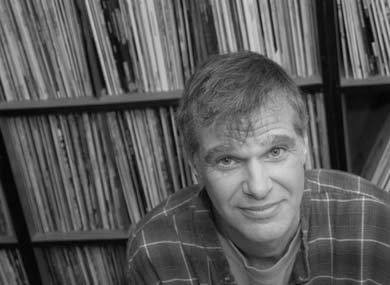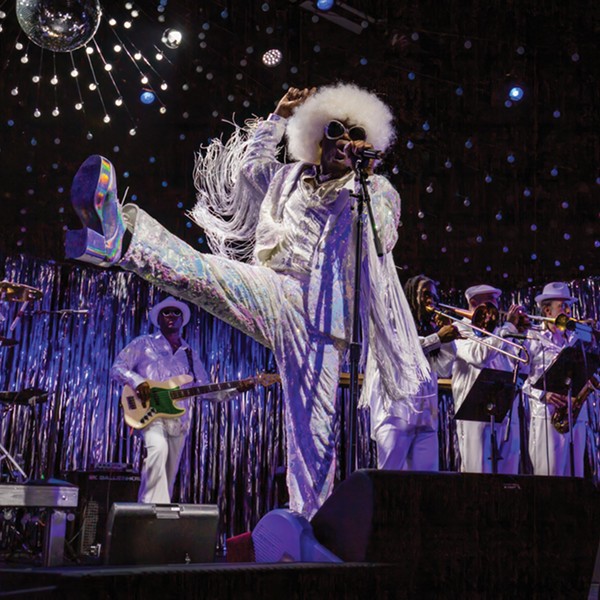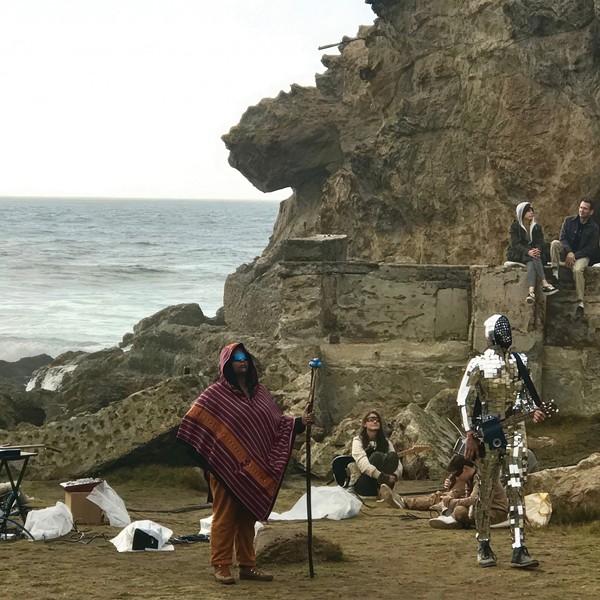Gene Santoro has no idea how many musicians he's interviewed. A music writer for 25 years, with four published books and regular columns in the Nation and the New York Daily News, he can only estimate that it's "somewhere in the thousands." He laughs. "Kind of horrifying."
Most people would be more thrilled than horrified to converse with the likes of Eric Clapton, Miles Davis, the Neville Brothers, Lyle Lovett, Gilberto Gil, K.D. Lang, Sting, or Sun Ra. Whatever you've got in your CD rack, Santoro's probably written about it.
Santoro's chosen to meet at Bodacious Bagels in Stone Ridge, a healthy bike ride from his Shokan home, where he's lived for the past 14 years with his wife and two daughters. When Santoro arrives, however, it's by car. There's a 60 percent chance of thundershowers, and he grumbles, "You know it'll rain if I'm on the bike."
Santoro is on deadline as usual, but glad to interrupt a grim stretch of writing obituaries for Ray Charles, Steve Lacy, Elvin Jones, and his close friend Robert Quine, legendary guitarist for Lou Reed and others. "It's been a bad couple of weeks," Santoro says, running a hand through close-cropped graying hair. Ronald Reagan has also just died, and Santoro notes, "A lot of people had it in for Ray Charles because he was a stone solid Republican-he sang at Reagan's inauguration. But he was completely self-made, in all senses. He owned most of himself: copyrights, music. He wrote his own charts, hired and fired his own bands, negotiated his own contracts. He had the ultimate say in his own life, and changed all of ours in the course of doing it."
Charles' musical impact was seismic. "Every singer heard that sound, how he put that rasp in the back of his throat. 'I've Got a Woman' was the first time you really hear that completely loose, Ray Charles sound. He recorded it live with his road band-[which is] like having sex with somebody you've already had a couple of rounds with; you know how to move with each other, how to give back and forth." Writing about Charles in his recent book Highway 61 Revisited (Oxford University Press, 2004, $32), Santoro limns him as a direct descendant of Louis Armstrong and a founding father of soul music, who fused the separate strands of holy gospel and "satanic" blues with that same 1955 hit.
Highway 61 Revisited bears the weighty subtitle "The Tangled Roots of American Jazz, Blues, Rock and Country Music." A wary reader might squint at the cover, with its photos of Louis Armstrong, Woody Guthrie, Bruce Springsteen, and Willie Nelson, and think, "All that in 300 pages?"
Well, yes. This is Santoro's fourth book for Oxford University Press, following an acclaimed biography of protean bassist Charles Mingus, Myself When I Am Real, and two collections of essays, Dancing In Your Head and Stir It Up. If these last two are roughly analogous to Greatest Hits anthologies, Highway 61 Revisited is a concept album. "I wanted to do a book, with a narrative shape," he explains. The opening section, "Avatars," consists of two long chapters on Louis Armstrong and Woody Guthrie. Santoro sees these mythic figures as the twin strands of DNA that spiral through American music, recombining in countless variations.
"This is how I think about American pop culture," he says. "Armstrong and Guthrie were the opening, in Marxist or Hegelian terms, of a dialectical process that you watch unfolding for the next 50 years, how those different strands came independently and together through American culture. Armstrong and Guthrie stand for larger things-race, certain tendencies in American culture-and you can trace the way their descendants intertwine, mesh, and change sides." As examples, he cites Cassandra Wilson singing Guthrie's "This Land Is Your Land" and Ani DiFranco backing her protest guitar with a jazz sextet. He leans forward, on a roll. "American pop culture is broader and deeper than America itself. It takes in more influences from outside and uses them-it's not embarrassed, ashamed, or frightened by what's unfamiliar. Unlike the people who live here."
This is vintage Santoro. He's an astonishing talker, quick-witted, wide-ranging, and fast. His conversation careens from erudition to street slang in dizzying, free-associative riffs that somehow always loop back to the theme from an unexpected direction, like Coltrane solos. His prose echoes his speaking voice in its depth and variety, often seeming to mimic the sound of the artist he's writing about.
"I try to make you hear the music that person does. It was a conscious choice 25 years ago; now it's just my style. It's intuitive on that complicated level that all serious craft is. I've learned how to shape it, and now, after 25 years, it's intuitive."
Santoro's musical roots were unprepossessing. "If you believe my mother, I used to fall asleep happily listening to Perry Como. I always remind her that I fell asleep." He grew up in blue-collar Brooklyn and Queens, "the kind of neighborhood where you're either going to be a cop or a robber." His father owned a liquor store; his mother worked at Korvette's, the now-defunct discount retailer. Their musical tastes ran with the post-war mainstream: Frank Sinatra, Tommy Dorsey, Mario Lanza. But Santoro's older cousins turned him on to Elvis Presley and folk music, and he started playing guitar at age eight. He played in his school band, and later, in "garage bands with everybody in my neighborhood-we did covers from all over the place: rock'n'roll, soul, R&B, even show tunes, when we started playing bar mitzvahs and weddings."
Young Gene and his band-mates listened to "whatever was on the radio...Murray the K, playing stuff late at night. We heard Little Richard, not the Pat Boone cover." They found black radio stations way at the top of the dial and said to each other, "What's this??"
The garage band guitarist had always enjoyed music and writing-he wrote plays in grade school, and won a Fulbright Scholarship as a young academic-but these loves didn't intersect until he was an editor at William Morrow, working on an anthology called The Guitar. One of his contributors asked Santoro why he was editing instead of writing. Remembering that moment 25 years later, he grins, hitting his forehead ironically, "Write what you know!"
Santoro started freelancing for magazines like Guitar Player, Down Beat, and Guitar World. Playing guitar often gave him an inside advantage-"Musicians read your stuff and give you that left-handed compliment, 'You got it right.' Well, that's the job, isn't it?" Sometimes "the job" has incredible perks, like hanging out with Jeff Beck for a week in England, or, one golden evening, getting to jam with his early idol Keith Richards. Santoro had interviewed Ron Wood, who invited him to hang out at the studio while the Stones laid down Dirty Work. "One night Woody hands me this white hollow-bodied Gretsch guitar and says, 'You know you want to.' We jammed for about an hour. I had a great time playing Keith Richards' licks back at him." Asked if the guitar great gave him any feedback, Santoro just shrugs. "He kept playing. That was all the feedback I needed." Richards also invited him back to his apartment, fed him shepherd's pie, and played vintage reggae tapes he'd made in Jamaica.
Not all musicians are so accommodating. Santoro cites Paul Simon as one of the hardest to crack. "He was monosyllabic, wouldn't give me an inch." Finally Santoro resorted to baiting the star with an unflattering comment made by another critic. Simon's temper flared, and he started talking nonstop. The interview opens Stir It Up.
Interviewing, Santoro says, is the art of sussing people out. "You need to have the information on the tips of your fingers so you can respond quickly to wherever they go. Interviewing is like improvisation: It's not just ad libbing and filling up space."
Myself When I Am Real intersperses verbatim quotes with the text. "The structure is highly musical in form. Mingus wrote extended compositions that were elastic, with space for solos that were meant to be integrated back into the master theme. The long interviews are like solos. Different people carry different themes."
Santoro worked on the manuscript for six years. "It took me three years to get off the daily journalism crack pipe-I was shoveling out three to six stories a week that land in the laps of millions of people. It's a pace like a runner; you never slow down. I had to cut way back to concentrate on the book." Inspired by Mingus' music, Santoro set out to challenge the "standard-issue thumbnail sketch" of "Jazz's Angry Man," including some myths spun by Mingus himself. The portrait of the man and his work that emerges in Myself When I Am Real is multidimensional and appreciative, the work of a scholar and fan.
Mingus seems an apt subject for a writer who also straddles many worlds. Not only does Santoro write about music as diverse as Hawaiian lilt, Afropop, and Ornette Coleman's harmolodics, he provides a historical and cultural context, referencing everyone from Michel Foucault to the Marx Brothers. "Music is eclectic," he says, "because life is eclectic."
Santoro is on his way to the JVC Jazz Festival, which he will cover for the Daily News, the Nation, NPR, and "anyone else who'll pay me." He starts to sound the familiar freelancer's dirge about piecing together a living by writing, then stops in mid-sentence and grins. "I've had a great life. I'm getting away with it."

















